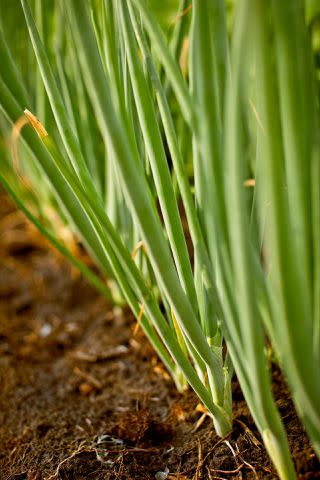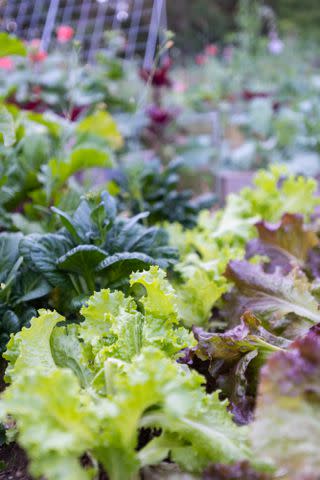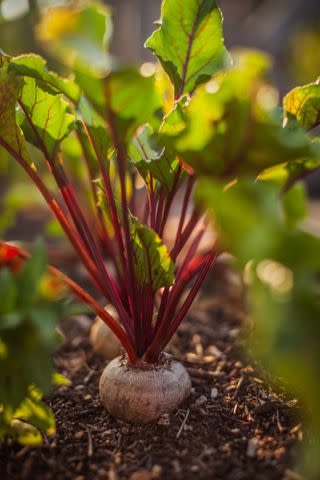10 Best Companion Plants for Peppers
Increase your harvest and keep destructive pests away with these companion plants for peppers.

Companion planting can help you grow healthier, disease- and pest-free bell pepper plants while avoiding the use of toxic pesticides. By choosing the right companion plants for peppers, you can improve your garden soil, repel problem pests organically, and maximize your garden space. Use this guide to find the best companion plants for bell peppers and fiery hot peppers, too.
Tips
Planting tomatoes and peppers together may seem like a good idea at first; however, these plants are susceptible to the same pests and pathogens and don’t make good companions.
Allium

Aphids are some of the most common pepper pests, causing distorted and yellow leaves when they feed on plant sap. Luckily, chives, onions, leeks, and other alliums naturally repel aphids and other problem insects and make good companion plants for peppers. Even better, if you allow your chive plants to bloom, their cheery purple flowers will attract pollinators to increase your pepper harvest.
Related: 16 Pretty Allium Varieties to Add an Explosion of Color to Your Garden
Basil

Basil is well-known for being an excellent companion for tomatoes, but it also works well for peppers too. Basil’s strong scent helps it to repel a wide variety of common pests, including thrips. In turn, pepper plants’ taller size offers some afternoon shade to nearby basil, helping to shield the herb’s tender leaves from too much bright sun.
Beans and Peas

Bob Stefko
With the help of certain bacteria, beans, peas, and other legumes have the ability to naturally add nitrogen to the soil and improve soil health overall. Beans and peas planted as companion plants for peppers can give your plants a nutrient boost and promote more vigorous growth. To keep your legumes from overwhelming your pepper plants, try building some cattle panel trellising or opt for bush-type beans and peas, which stay more compact.
Bok Choy

Pepper plants can be targeted by flea beetles, which will chew holes in plant leaves and may transmit bacterial wilt. To avoid this, plant bok choy near your pepper plants to act as a “trap crop.” Flea beetles and other pests prefer bok choy leaves and will naturally congregate on these plants, helping to keep your peppers pest-free.
Related: How to Get Rid of Flea Beetles in Your Garden
Cilantro

Growing cilantro as a companion plant for peppers isn’t just good for homemade salsas. It’s also one of the best choices for organic pest control. Cilantro flowers attract all kinds of beneficial insects, such as parasitic wasps, lacewings, and ladybugs. These insects feed on aphids and other common pepper pests.
Cucumbers and Squash

Cucumbers and squash plants pair well with peppers because their low growth habit shields the soil from direct sun, prevents weeds, and keeps your soil from drying out too quickly. If you choose to grow cucumbers as groundcovers without trellising, try adding organic mulch around your plants, which will keep your cucumbers from touching bare soil, which can promote rot.
Hot Cherry Peppers

dial-a-view / Getty Images
Surprisingly, hot cherry peppers are some of the best companion plants for bell peppers you can grow. Bell peppers can be vulnerable to pepper maggots, which bore holes into developing fruit and cause it to rot on the plant. However, research has shown that that these pests prefer hot cherry peppers to other pepper varieties and sowing the cherry peppers as trap crops can help keep the rest of your peppers safe.
Lettuce

Kindra Clineff
Lettuce is an undemanding, fast-growing, cool-season vegetable that can be added in between a few pepper plants. Interplanting lettuce or other leafy greens among your peppers will put empty soil to good use. Additionally, peppers can offer a bit of afternoon shade to your lettuce plants, slowing down bolting and prolonging harvest.
Related: 4 Best Types of Lettuce to Grow in Your Garden
Root Vegetables

Bob Stefko
Carrots, beets, radishes, and other root vegetables grow low to the ground, so you won’t need to worry about them competing with your pepper plants for sunlight. But interplanting root vegetables among your pepper plants is also a smart way to get the most out of your garden space. While waiting for your peppers to mature, sow fast-growing root vegetables around your pepper plants and harvest them in just a few weeks.
Sunflowers

Sunflowers’ big, flat flower heads make them especially alluring to bees and other pollinators. Increasing pollinator activity near your pepper plants will boost pollination rates and lead to more harvestable peppers. If you’re working with a small garden space, but still want to try companion planting with sunflowers, look for dwarf varieties that stay much more compact.
Companion Plants to Grow Together
Most vegetables benefit from companion planting. For zucchini, plant dill to attract pollinators and parasitic wasps that will keep squash vine borers under control. Cabbage and celery grow well together because they have the same soil and watering needs, and celery's aroma keeps away destructive cabbage loopers. Grow radishes nearby to keep your pumpkins free of flea beetles since these pests prefer radishes for snacks. If you have potatoes in your garden, nasturtium is a good choice for its pretty flowers and trap crop abilities. Plus, nasturtium flowers are edible.
For more Better Homes & Gardens news, make sure to sign up for our newsletter!
Read the original article on Better Homes & Gardens.

